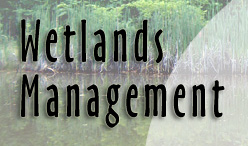When many
people think of wildlife in wetlands they
automatically think of waterfowl. Waterfowl
which include ducks, geese, and swans are
enjoyed by hunters and non-hunters alike.
There are at least 46 species of waterfowl
that are known to occur in North America,
but species that commonly breed in North
America include 34 ducks, 6 geese, and 3
swan species.
|
Some waterfowl, such as a drake mallard, are easily
recognized by everyone. However, some species such
as gadwalls and ring-necked ducks are only easily
recognized by hunters and birders. Ducks are
generally classified as
dabblers, sometimes called
puddle ducks, or
divers, although there are a few
other exceptions. Dabbling ducks include mallards
and similar species that have bright colored wing
patches and commonly occur in wetlands. Divers, or
diving ducks, include canvasbacks and redheads which
generally occur in deeper open-water bodies.
Dabbling ducks can spring into the air and fly away,
whereas diving ducks need to run across the water
flapping their wings in order to become airborne. As
their name implies, diving ducks often dive below
the surface of the water to feed, but dabbling ducks
feed from the surface by tipping their head below
the water. |
|

See
a mallard feeding. |
To
learn to identify waterfowl species view this
publication from the
Northern Prairie Wildlife Research Center or
visit the
Ducks Unlimited web site.
|
|
Importance of Wetlands for Waterfowl |
Most waterfowl
depend on wetlands during part of the year. Many
species of ducks raise their broods in wetlands.
Dabbling ducks prefer shallower wetlands whereas
diving ducks use deeper wetlands. The best wetlands
for waterfowl broods generally have 50% open water
and 50% emergent vegetation. Wetlands with this type
of vegetation pattern are termed hemi-marshes. A
hemi-marsh provides adequate food and cover to
maximize waterfowl use.
|
|
|
|
Geese
often roost on wetlands at night. The best
wetlands for roosting are generally large
open-water wetlands, with a periphery of
robust emergent vegetation that provides a
visual and physical barrier from the
surrounding land.
 See
goose habitat. See
goose habitat.
Click here to see
Snow Geese.
|
Most waterfowl feed heavily in a diversity of
wetland types. They consume a variety of aquatic
plant roots, seeds, and stems, and also forage on
aquatic invertebrates. Some of the most productive
wetlands for foraging ducks dry annually (seasonally
flooded wetlands) allowing annual plants to
germinate from seeds, and grow. After seeds have
been produced and water has filled the wetland
again, ducks move into the wetland and consume the
abundant seeds. Landowners can mimic nature, and
manage their wetlands for increased waterfowl forage
through a process called moist-soil management.
Visit the moist-soil management page for more
information.
Click on the following to learn more about the life
history of select waterfowl species.
|

